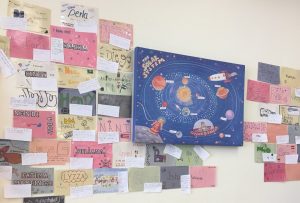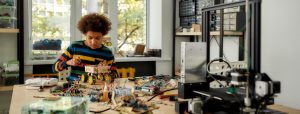In education, especially STEM education, teachers often find themselves face to face with jargon. Often, it can feel like there are new words every school year! Each of which your administration is mandating you implement in your classroom. Today we’re going to take some time to break down some of the new buzzwords popping up around social justice and show you what they look like in a STEM classroom, even if you’re remote teaching. While these strategies are certainly good ones, they can be daunting to attempt. The best part? You’re probably already doing some of it! So let’s walk through each, see some examples, and talk about implementation.

Restorative Justice (RJ)
What is it?
The Suffolk Restorative Justice Center states, “Restorative justice is a broad term encompassing a growing social movement to institutionalize peaceful approaches to harm, problem-solving, and violations of legal and human rights. Restorative approaches seek to balance the needs of the victim, wrongdoer, and community through processes that preserve the safety and dignity of all.” In the classroom, it is an approach used to build community that will be the foundation for conflict resolution through repairing harm.
What does it look like in a STEM classroom?
For STEM specifically, RJ aids us in creating a space for discussion, participation, and activities. When a classroom community is built upon mutual values, discussions can be much richer, participation is greater, and activities can be engaged in at a higher level. One example of RJ is the talking circle. This is when students all sit in a circle and pass around a talking piece where every student is able to present their answers. In STEM, utilizing the circle during labs can aid in communal understanding of phenomenon (see image below). The Center for Restorative Justice states, “By asking students what they found most important, useful, challenging, thought-provoking, applicable, or confusing in a unit, the teacher can identify the learning needs and reinforce key content.”

What is it not?
RJ sometimes gets categorized as “just talking it out” or “lacking consequences.” These are both false. RJ does allow for ease of class discussions and smaller group discussions as community has been developed, but it is a process of repairing harm where the wrongdoer and the victim are able to safely discuss their points of view and reach a consequence that repairs the harm done in the community. It is also not just a way to “talk” but also a way to learn!
How do I do this remotely?
Talking circles are a great way to establish community and engage discussion remotely as well! The book “Circle Forward” has community building talking circles that can be turned into slides to present to students. The “virtual talking piece” can be utilized via any video platform and just allows students to each have an opportunity to share their understanding.
How can I try this tomorrow?
Try taking a circle from “Circle Forward” and utilizing it in your remote learning class. You can also make your own talking circle about a STEM topic using this template! You could also just try using a talking piece during a class discussion to allow each person an opportunity to talk.
Culturally Responsive Teaching (CRT)
What is it?
Dr. Gloria Ladson-Billings defines CRT as “a threefold approach to ensuring that all children are successful. That approach requires a focus on students’ learning, an attempt to develop their cultural competence, and to increase their sociopolitical or critical consciousness.” All three of these pillars must be applied to ensure student success.
What does it look like in a STEM classroom?
Academic Success
This is what many teachers focus on when teaching regularly. We want our students to be successful. This remains unchanged, but with a greater focus on involving students in their own learning.
Cultural Competence
This is allowing students to understand how they as an individual fit in to the learning of STEM. This involves windows and mirrors where students can see themselves in the STEM curriculum, as well as discussing STEM heroes of varying backgrounds.
Sociopolitical Consciousness
This means bringing in current events about STEM and bringing a consciousness to your teaching about those events. STEM current effects are impacted by our sociopolitical climate, and bringing that into the classroom allows students to be partners in their learning.
Additionally, I wrote a previous blog article all about practicing Culturally Responsive Teaching in STEM which you can read here.
What is it not?
CRT is not hanging a picture of Neil deGrasse Tyson on your wall and stopping there. CRT is not using names from diverse backgrounds in your word problems and then stopping there. CRT is not talking about black scientists during black history month and then stopping there. These are all important steps, but do not, on their own, mean a teacher’s work is culturally relevant or responsive.
How do I do this remotely?
Ask students about their own backgrounds to learn about who they are. RJ strategies can help with this. Then utilize the discussion of STEM current events, while talking about the current political climate in STEM. These conversations combined with academic achievement can all be utilized remote or in person.

How can I try this tomorrow?
Try putting a STEM current event into your lesson or talking about our current political climate and how that relates to STEM and your students. If that is not where you are in your teaching, you can read Zaretta Hammond’s book Culturally Responsive Teaching and the Brain, wherein she discusses neuroscience about this innovative teaching method.

In the end, you’re probably already doing some of this! Next time your principal asks you to implement yet another buzzword, take it in stride and know it only takes a slight rearrangement or tweak to your lesson. You’ve got this!
Check out the other blogs in Savannah’s Breaking Down the Buzzwords series:
Breaking Down the Buzzwords: Modeling and Phenomenon-Based Learning
Breaking Down the Buzzwords: Inquiry and Project-Based Learning
Breaking Down the Buzzwords: 21st Century Skills and Design Thinking







Leave A Comment